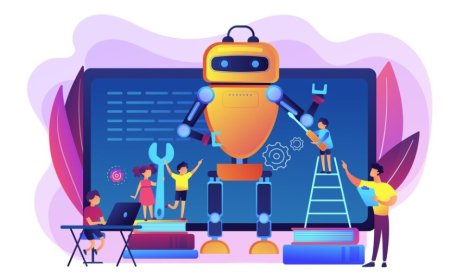Machine learning framework for experts in 2024
Explore machine learning, framework, experts, 2024, models, algorithms, tools, AI, data, techniques, development, trends.

For specialists in the field of artificial intelligence and machine learning, 2024 will be a critical year in this rapidly changing industry. Machine learning frameworks are becoming crucial instruments for addressing complicated problems and expanding the frontiers of innovation because of the increasing quantity of data and the rising complexity of tasks. By 2024, it will be necessary for professionals to sort through a multitude of frameworks to find the ones that best meet their unique requirements.
we set out on a quest to investigate the top machine-learning frameworks designed for specialists in 2024. We will examine the features, functionality, and adaptability of these frameworks in detail. Using an extensive examination, our objective is to furnish specialists with the understanding and perceptions required to make well-informed choices when choosing the best instruments for their complex projects.
In 2024, machine learning has advanced to previously unheard-of levels, and professionals are faced with a wide range of difficult problems. Due to the proliferation of data coming from sensors, social media, IoT devices, and other sources, specialists are faced with the challenge of collecting valuable insights from huge quantities of data. In addition, the need for advanced AI applications like computer vision, natural language processing, and autonomous systems keeps growing, demanding the development of advanced machine learning frameworks that can accurately and efficiently perform complex tasks.
Machine learning professionals are the leaders of innovation, working to build solutions that address real-world challenges across multiple fields as technology becomes more and more integrated into daily life. But this increase in demand also presents an issue: selecting the appropriate framework. Experts must sort through a confusing array of choices, from Python and PyTorch to more recent additions like JAX and Hugging Face Transformers, to determine which ones are most appropriate for their particular requirements. The current dynamic environment demands a greater awareness of the leading machine learning frameworks and their potential to help specialists in the fields of innovation and influence.
Challenges faced by machine learning experts in 2024
Data Quality and Quantity:
-
Providing the availability of high-quality marked data for model training, both in terms of size and quality.
-
handling distorted, distracting, or incomplete datasets that could produce incorrect results.
-
managing the huge quantity of data produced by numerous sources, such as detectors, social media, and Internet of Things devices.
Model Readability and Complexity:
-
Handling the growing complexity of machine learning models, like millions-parameter deep neural networks.
-
finding a balance in the trade-off between understanding and model complexity, particularly in sectors like banking and healthcare where explainability is important.
Scalability and Performance:
-
Providing the availability of high-quality marked data for model training, both in terms of size and quality.
-
handling distorted, distracting, or incomplete datasets that could produce incorrect results.
-
managing the huge quantity of data produced by numerous sources, such as detectors, social media, and Internet of Things devices.
Model Readability and Complexity:
-
Handling the growing complexity of machine learning models, like millions-parameter neural network models.
-
finding a balance in the trade-off between understanding and model complexity, particularly in sectors like banking and healthcare where explainability is important.
Deployment and Operationalization:
-
Simplifying the process of putting machine learning models into production to close the gap between research and deployment.
-
constructing machine learning pipelines that are reliable, scalable, and maintainable for continuous integration and delivery.
-
tackling issues with versioning, governance, and model monitoring in real-world settings.
Adversarial attacks and Security:
-
Guarding machine learning models from assaults that try to skew or manipulate their predictions.
-
constructing strong defenses and detection systems to recognize and address security risks in machine learning systems.
Which framework is best for machine learning
-
TensorFlow:
-
Developed by Google, TensorFlow is widely adopted in both academia and industry.
-
Offers a flexible architecture suitable for a wide range of tasks, from deep learning to traditional machine learning.
-
Provides high-level APIs like Keras for easy model building and lower-level operations for advanced customization.
-
TensorFlow Extended (TFX) facilitates end-to-end machine learning pipelines for production deployment.
-
Strong community support with extensive documentation and resources available.
-
PyTorch:
-
Developed by Facebook's AI Research lab, PyTorch is favored by researchers for its dynamic computation graph and ease of use.
-
Offers a Pythonic interface that facilitates rapid prototyping and experimentation.
-
Well-suited for tasks requiring flexibility and customization, such as research projects and novel model architectures.
-
A strong ecosystem with libraries like TorchVision for computer vision and TorchText for natural language processing.
-
Continuously evolving with regular updates and contributions from the community.
-
Scikit-learn:
-
Built on NumPy, SciPy, and matplotlib, scikit-learn is a simple and efficient tool for data mining and machine learning.
-
Provides a wide range of algorithms for classification, regression, clustering, dimensionality reduction, and more.
-
Easy-to-use API and comprehensive documentation make it suitable for beginners and experts alike.
-
Supports interoperability with other Python libraries and frameworks.
-
Ideal for traditional machine learning tasks and prototyping.
-
JAX:
-
Developed by Google Research, JAX is gaining popularity for its combination of flexibility and performance.
-
Built on top of NumPy, JAX offers automatic differentiation and GPU/TPU acceleration.
-
Enables composable function transformations for building custom models and algorithms.
-
Well-suited for tasks requiring high-performance computing and custom optimization.
-
A growing ecosystem with libraries like Haiku for neural network building.
-
Hugging Face Transformers:
-
Specialized in natural language processing tasks, Hugging Face Transformers provides pre-trained models and state-of-the-art algorithms.
-
Offers a simple and intuitive API for fine-tuning models on specific tasks.
-
Supports a wide range of tasks, including text classification, sentiment analysis, named entity recognition, and more.
-
Easy integration with PyTorch and TensorFlow frameworks.
-
Active community and regular updates ensure access to the latest advancements in NLP.
In 2024, experts in artificial intelligence and machine learning will face a wide range of difficulties, from managing huge amounts of data to implementing advanced models in practical settings. Choosing the appropriate machine learning framework is crucial for solving these problems successfully. While there are several excellent frameworks available, such as Hugging Face Transformers, scikit-learn, PyTorch, TensorFlow, and JAX, the optimal option will rely on the user's experience level and the specific needs of the project. Every framework has advantages and strengths of its own, varying from community support and ease of use to performance and flexibility.





































